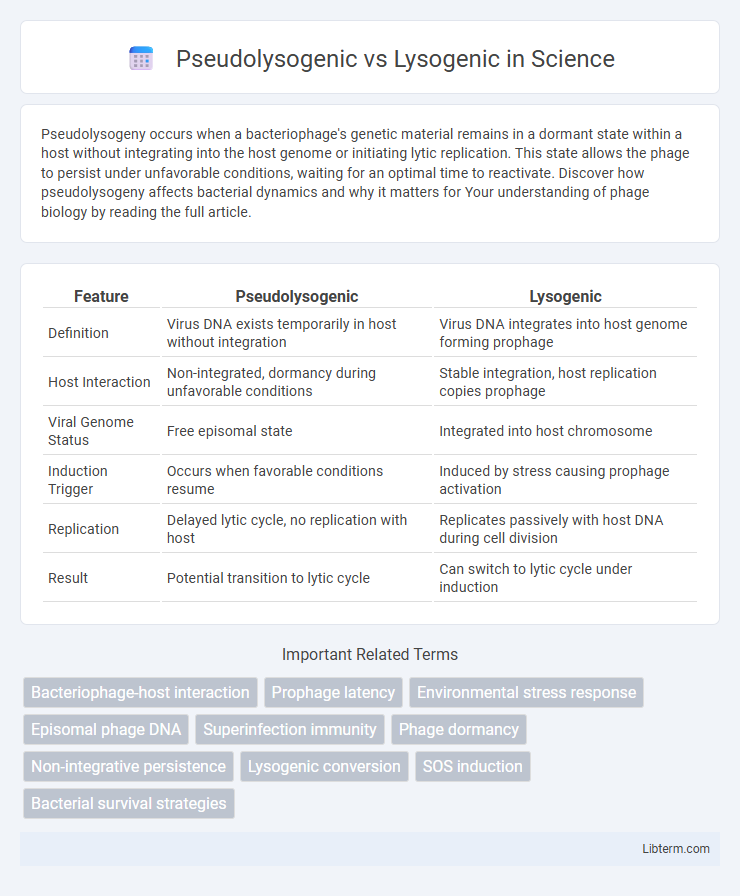Pseudolysogeny occurs when a bacteriophage's genetic material remains in a dormant state within a host without integrating into the host genome or initiating lytic replication. This state allows the phage to persist under unfavorable conditions, waiting for an optimal time to reactivate. Discover how pseudolysogeny affects bacterial dynamics and why it matters for Your understanding of phage biology by reading the full article.
Table of Comparison
| Feature | Pseudolysogenic | Lysogenic |
|---|---|---|
| Definition | Virus DNA exists temporarily in host without integration | Virus DNA integrates into host genome forming prophage |
| Host Interaction | Non-integrated, dormancy during unfavorable conditions | Stable integration, host replication copies prophage |
| Viral Genome Status | Free episomal state | Integrated into host chromosome |
| Induction Trigger | Occurs when favorable conditions resume | Induced by stress causing prophage activation |
| Replication | Delayed lytic cycle, no replication with host | Replicates passively with host DNA during cell division |
| Result | Potential transition to lytic cycle | Can switch to lytic cycle under induction |
Introduction to Bacteriophage Life Cycles
Bacteriophage life cycles include lysogenic and pseudolysogenic states where phages integrate differently with the bacterial host. Lysogenic cycles involve the integration of phage DNA into the host genome, creating a prophage that replicates with the host cell without causing immediate lysis. Pseudolysogeny represents a temporary, non-integrated state in which phage DNA remains dormant in the host cytoplasm, often under unfavorable conditions, delaying active replication or lytic activity.
Defining Lysogenic Cycle
The lysogenic cycle involves the integration of a bacteriophage's genome into the host bacterium's DNA, allowing the viral genome to replicate passively as the host cell divides without causing immediate lysis. In contrast, pseudolysogeny describes a temporary, non-integrative state where the viral genome remains dormant in the host cytoplasm under unfavorable conditions, delaying replication until conditions improve. Understanding the lysogenic cycle is essential for studying bacterial immunity, horizontal gene transfer, and phage therapy mechanisms.
Understanding Pseudolysogeny
Pseudolysogeny occurs when a bacteriophage enters a bacterial cell but does not integrate its genome into the host DNA or immediately initiate the lytic cycle, resulting in a dormant state where viral DNA persists without replication. Unlike lysogeny, where the phage genome integrates into the host chromosome as a prophage and replicates synchronously with the host, pseudolysogeny is often influenced by unfavorable environmental conditions that prevent stable phage-host interactions. Understanding pseudolysogeny is crucial for studying phage-host dynamics, especially in fluctuating environments where bacterial growth rates and metabolic activity impact phage infection outcomes.
Key Differences: Pseudolysogenic vs Lysogenic
Pseudolysogenic cycles occur when phage DNA remains inactive in the host without integrating into the host genome, often due to unfavorable conditions, whereas lysogenic cycles involve phage DNA integration into the host chromosome as a prophage. In lysogeny, the viral genome replicates synchronously with the host cell, allowing stable inheritance, while pseudolysogeny results in a temporary, non-replicative state of viral DNA. The lysogenic cycle can eventually lead to the lytic cycle through induction, but pseudolysogeny typically ends without proviral replication or immediate host cell lysis.
Molecular Mechanisms Behind Lysogeny
The molecular mechanisms behind lysogeny involve the integration of the phage genome into the bacterial chromosome, facilitated by integrase enzymes and specific attachment sites, allowing stable prophage maintenance. In contrast, pseudolysogeny occurs when the phage genome remains episomal or unintegrated within the host cell without active replication or lysogen formation, often triggered by host stress or nutrient limitation. Lysogenic cycles are regulated by repressor proteins such as CI, which inhibit the lytic genes and ensure prophage dormancy, whereas pseudolysogeny lacks such stable genetic control, leading to a transient state.
Triggers and Conditions for Pseudolysogeny
Pseudolysogeny occurs under stressful or nutrient-limited conditions where the phage DNA neither integrates into the host genome nor initiates the lytic cycle, resulting in temporary maintenance of the viral genome without replication. In contrast, lysogeny is triggered by favorable conditions that promote viral DNA integration into the host chromosome as a prophage, ensuring stable inheritance during cell division. Pseudolysogenic states typically arise in environments with fluctuating resources, affecting phage-host dynamics and delaying viral replication until conditions improve.
Impact on Bacterial Hosts
Pseudolysogenic states often result in temporary viral persistence without integration into the bacterial genome, allowing bacteria to survive harsh conditions but limiting long-term genetic alterations. Lysogenic cycles involve the integration of phage DNA into the bacterial chromosome, promoting stable genetic changes that can confer advantages such as toxin production or immunity to superinfection. These fundamental differences affect bacterial adaptability, survival strategies, and ecological interactions within microbial communities.
Ecological and Evolutionary Significance
Pseudolysogeny allows bacteriophages to persist in host bacteria under unfavorable conditions without immediately integrating into the genome, maintaining viral populations during environmental stress and nutrient limitation. In contrast, lysogeny involves stable integration of the phage genome into the host DNA, enabling long-term coevolution and horizontal gene transfer that can enhance bacterial adaptation and ecological fitness. Both mechanisms shape microbial community dynamics and influence genetic diversity, with pseudolysogeny providing a reversible dormancy strategy and lysogeny promoting genetic innovation and stability within ecosystems.
Implications for Phage Therapy
Pseudolysogenic infections, where phage DNA remains inactive without integration, pose challenges for phage therapy due to unpredictable bacterial lysis and potential persistence of pathogens. Lysogenic cycles involve stable integration of phage DNA into the bacterial genome, allowing for controlled prophage induction, which can be harnessed for targeted bacterial eradication. Understanding the balance between pseudolysogeny and lysogeny is critical for optimizing phage therapy efficacy and minimizing resistance development.
Future Research Directions
Future research on pseudolysogenic versus lysogenic cycles will likely explore the molecular triggers that determine the switch between these viral replication strategies in bacteriophages. Advances in CRISPR-Cas technology may enable precise manipulation of phage genomes to unravel regulatory mechanisms controlling prophage induction and pseudolysogeny stability. Understanding environmental and host factors influencing these cycles could lead to innovative phage therapy approaches targeting antibiotic-resistant bacterial populations.
Pseudolysogenic Infographic

 libterm.com
libterm.com